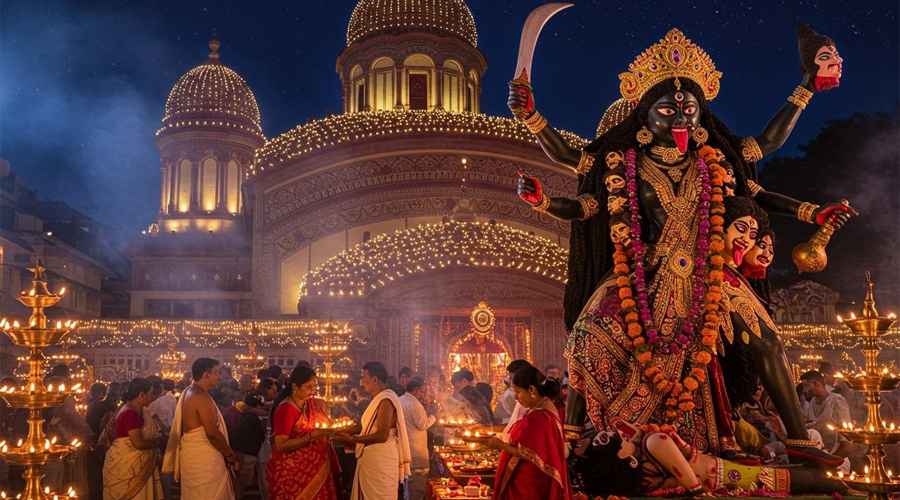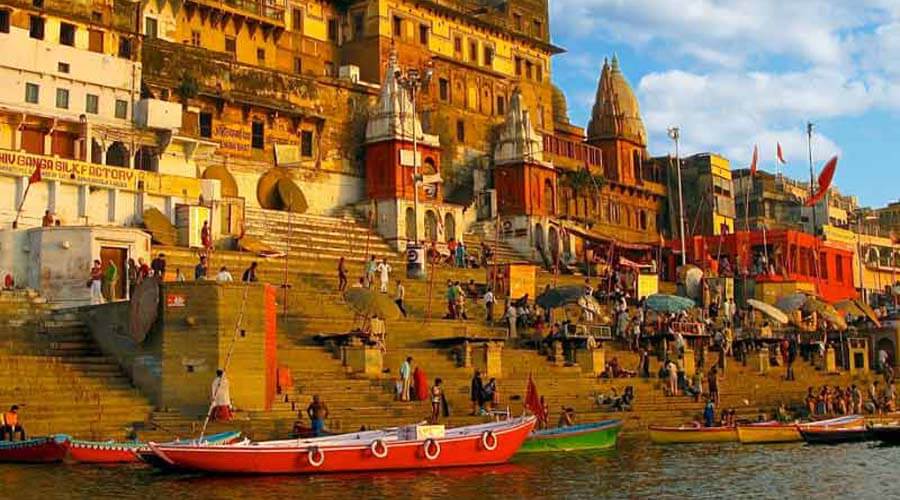Kalighat Temple, located in the vibrant city of Kolkata, West Bengal, stands as one of the most revered places of worship dedicated to Goddess Kali, the fierce form of the Divine Mother. It is not only a prominent religious destination but also a landmark deeply connected with Bengal’s cultural and spiritual heritage. As one of the 51 Shakti Peethas in India, the temple attracts millions of devotees each year who come to seek the blessings of Goddess Kali, believed to be the destroyer of evil and the protector of her devotees. Beyond religion, the temple is an expression of Kolkata’s identity, blending mythology, rituals, history, and devotion.
Mythological Significance
Kalighat’s sanctity is rooted in the legend of Goddess Sati. According to Hindu mythology, when Sati, the consort of Lord Shiva, self-immolated at her father Daksha’s sacrificial ceremony, Shiva carried her body across the universe in pain. To pacify him, Lord Vishnu used his Sudarshan Chakra to cut Sati’s body into 51 parts, which fell on different spots across the Indian subcontinent, giving rise to the Shakti Peethas. Kalighat is believed to be the site where the toes of Sati’s right foot fell, making it a supreme pilgrimage destination for worshippers of Shakti.
This mythical connection has made the temple a center of Tantric worship as well, with rituals often reflecting the deep and esoteric paths of devotion to Goddess Kali.
Historical Background
Though the present-day structure of Kalighat Temple was built in the early 19th century under the patronage of the Sabarna Roy Choudhury family, the temple’s origins are much older. References to Kalighat exist in ancient texts, and it is believed to have been a modest shrine long before its reconstruction into the temple we see today. Over time, Kalighat became an integral religious hub and earned the reputation of being the heartbeat of Kali worship in Bengal.
The temple also influenced the birth of the distinct Kalighat school of painting in the 19th century, where artists depicted divine figures, mythological themes, and even satirical portrayals of social life in vibrant paintings sold to visiting pilgrims. This gave Kalighat not just spiritual recognition but also a cultural stamp on Bengal’s history.
Architecture of Kalighat Temple
Kalighat Temple showcases typical Bengali architectural features, with its Nava-ratna style structure and a distinctive curved roof, called the chalchitra. Unlike ornate temples of North or South India, Kalighat has a simpler structure but holds immense spiritual power. At the heart of the temple lies the sanctum sanctorum where devotees have darshan of Goddess Kali.
The idol of the Goddess is unique: she is black in color, with three eyes and a long protruding golden tongue. The idol is adorned with gold and silver jewelry, and instead of conventional hands, the image has four pieces of gold representing her arms, each holding symbolic weapons and gestures. This divine form of Kali is both awe-inspiring and compassionate, representing her eternal energy.
Rituals and Worship
Worship at Kalighat Kali Temple is rooted in traditional Hindu rituals, with a strong Tantric influence. Daily offerings include flowers, sarees, and sweets, while special rituals take place during Tuesdays, Saturdays, and during the new moon—as these days are considered especially auspicious for the worship of Kali.
Animal sacrifices, particularly goats, have historically been an integral part of the offerings. These sacrifices, although controversial, are believed by devotees to symbolize the surrender of one’s ego to the Goddess. Over time, the tradition has faced challenges from modern sensibilities, and many devotees now prefer symbolic offerings instead.
The temple witnesses a huge influx of pilgrims during major Hindu festivals like Kali Puja, Durga Puja, and Diwali, when the entire complex is decorated with lamps and chants echo throughout the surrounding lanes.
The Temple Complex
In addition to the shrine of Kali, the temple houses shrines dedicated to Lord Shiva, Radha-Krishna, and other deities. Pilgrims often take a dip in the sacred Kund (tank) located near the temple, believed to purify sins. The surrounding lanes are lined with shops selling flowers, offerings, images of the Goddess, and souvenirs for devotees.
Kalighat is also famous for the presence of priests, locally called pandas, who guide devotees through the rituals. While their role is integral to temple worship, they are also sometimes criticized for commercial practices. Nevertheless, the overwhelming devotion of pilgrims continues to define the atmosphere at Kalighat.
Kalighat and Kolkata’s Identity
The importance of Kalighat Temple extends beyond religion—it has become a defining symbol of Kolkata. The very name of the city “Kalikata,” one of the three villages that formed modern-day Kolkata, is thought to have been derived from Kalighat. Thus, Kalighat is not only spiritually central but also historically tied to the city’s origins.
Over centuries, the temple has nurtured Kolkata’s image as a city of devotion, art, and culture. The Kalighat paintings, devotional songs in honor of Kali, and the enduring folk traditions show how the temple is woven sharply into Bengal’s identity.
Visiting Kalighat
Visiting Kalighat today is both a spiritual and cultural experience. Located in South Kolkata, the temple is easily accessible by metro and road. Despite the heavy crowds, the atmosphere is electrifying, with sounds of bells, conch shells, and chants filling the air. Many first-time visitors are struck by the vibrant energy that pervades the temple.
It is advisable to visit early in the morning to avoid long queues, particularly on Tuesdays and Saturdays. Photography inside the sanctum is restricted, allowing pilgrims to focus fully on their spiritual experience.
Conclusion
Kalighat Temple is not merely a place of worship—it is a living symbol of Kolkata’s soul. It embodies the strength of Goddess Kali, the devotion of countless generations, and the blend of mythology, art, and faith that defines Bengali culture. For devotees, a visit to Kalighat brings immense spiritual solace, while for travelers, it opens a window into Kolkata’s spiritual and cultural essence.
With its history deeply entrenched in mythology and its power still resonating today, Kalighat Temple remains one of India’s most sacred and awe-inspiring shrines dedicated to the Divine Mother.


